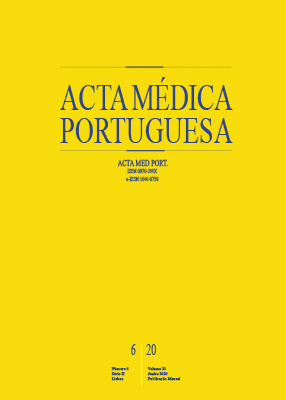Impact of Emergency Medical System Transportation in ST-segment Elevation Myocardial Infarction: A Nationwide Retrospective Study
DOI:
https://doi.org/10.20344/amp.11082Keywords:
Myocardial Reperfusion, Percutaneous Coronary Intervention, ST Elevation Myocardial Infarction, Time Factors, Time-to-TreatmentAbstract
Introduction: Emergency medical system transportation has been shown to reduce treatment times in ST-segment elevation myocardial infarction. The authors studied the Portuguese National Registry of Acute Coronary Syndromes to determine the nationwide impact of the emergency medical system transportation in the treatment of ST-segment elevation myocardial infarction.
Material and Methods: A multicentric, nationwide, retrospective study of ST-segment elevation myocardial infarction patients inserted in the National Registry from 2010 to 2017 was performed. The patients were divided into: Group I, composed of patients transported by emergency medical system, and Group II, patients arriving to the Emergency department by other means.
Results: Of the 5702 patients studied, 25.9% were transported via emergency medical system. Rates of emergency medical system activation increased by 17% in the last 7 years. The emergency medical system provided a higher rate of transport to a percutaneous coronary intervention capable centre, of Emergency department bypass, of on-site fibrinolysis, and ensured a 59-minute reduction of the median reperfusion time (p < 0.001). There was no difference in in-hospital mortality.
Discussion: In this nationwide cohort, emergency medical system transportation is associated with a reduction in reperfusion times. It provides a higher amount of salvaged myocardium and reduces the incidence of acute heart failure. However, emergency medical system use did not result in lower in-hospital mortality, probably due to confounding factors of higher disease severity and comorbidity.
Conclusion: The benefits associated with emergency medical system based transportation of patients with ST-segment elevation myocardial infarction do not translate into lower in-hospital mortality.
Downloads
Downloads
Published
How to Cite
Issue
Section
License
All the articles published in the AMP are open access and comply with the requirements of funding agencies or academic institutions. The AMP is governed by the terms of the Creative Commons ‘Attribution – Non-Commercial Use - (CC-BY-NC)’ license, regarding the use by third parties.
It is the author’s responsibility to obtain approval for the reproduction of figures, tables, etc. from other publications.
Upon acceptance of an article for publication, the authors will be asked to complete the ICMJE “Copyright Liability and Copyright Sharing Statement “(http://www.actamedicaportuguesa.com/info/AMP-NormasPublicacao.pdf) and the “Declaration of Potential Conflicts of Interest” (http:// www.icmje.org/conflicts-of-interest). An e-mail will be sent to the corresponding author to acknowledge receipt of the manuscript.
After publication, the authors are authorised to make their articles available in repositories of their institutions of origin, as long as they always mention where they were published and according to the Creative Commons license.









